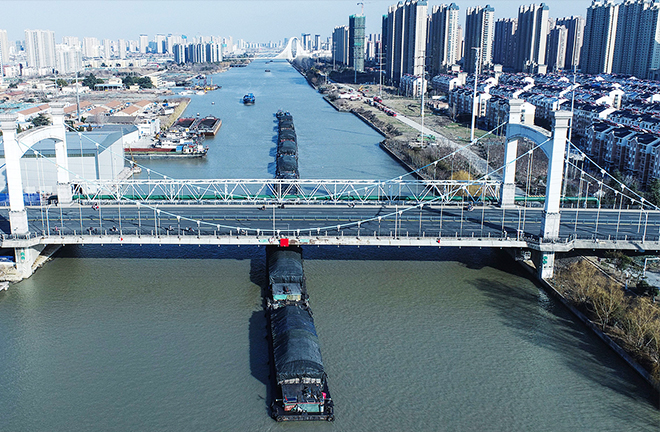Scholars enlighten traditional Jiangnan culture

Cargo ships sail on the Grand Canal in Huai’an, Jiangsu Province, on Feb. 21. Photo: CFP
A literature and history panel on the theme of “enhancing Jiangsu’s historical culture and advancing cultural innovative creation” was held at the 16th Academic Conference of Social Sciences in Jiangsu Province, serving the creative transformation and development of fine traditional Chinese culture.
Historical accumulation
“Under the interaction of the Yangtze River culture and the Grand Canal culture, the culture of Jiangnan [region south of the lower reaches of the Yangtze River] represents a significant form of historical and cultural heritage in the Jiangsu region,” said Han Yuxuan, an associate professor from the School of Humanities at Jiangnan University. The emergence of Jiangnan culture is closely related to the interplay between the Yangtze River culture and the canal culture. The Yangtze River culture, as a “natural axis,” has opened up development space for Jiangnan culture in terms of natural resources, economic resources, and existence posture, while the canal culture, as the “cultural axis,” has brought forth ample material, spiritual, and human resources to Jiangnan. Their joint influence has shaped a Jiangnan cultural spirit characterized by poetics and elegance, determination and innovation, tolerance and inclusiveness, earnestness and practicality. As a form with rich connotations and wide extensions in the map of Chinese culture, Jiangnan culture features “poetics–aesthetics.” Its inherent modernization factors have provided resources for the modernization of Chinese culture.
“The ‘water’ culture is a distinctive feature of Jiangsu’s regional culture,” said Jiang Qingbai, a research fellow from the School of Chinese Language and Literature at Nanjing Normal University. The numerous rivers spreading through Jiangsu, and the Grand Canal vertically connecting the Yangtze River and the Huai River, make “water” an indispensable part of the regional culture. Within Jiangsu, the canal runs through Xuzhou, Suqian, Huai’an, Yangzhou, Zhenjiang, Changzhou, Wuxi, and Suzhou. The river flows through the cities, and the cities thrive due to the river. In contrast with the surging Yangtze River, the canal is generally peaceful. In an agrarian age dominated by a slower pace of life and a self-sufficient natural economy, the canal shaped the traits of the Jiangsu people, who are bright, low-key, pragmatic, open-minded, inclusive, stable, and peaceful.
As an important regional cultural form in Jiangsu, Chu-Han culture mainly refers to the dynastic cultural form in the Xuzhou region during the Han Dynasty (202 BCE–220). Nowadays, the culture can find its most abundant and typical cultural relics in northern Jiangsu, especially in Xuzhou. According to Wang Jian, deputy director of the Research Institute of Han Dynasty Culture at Jiangsu Normal University, if exploring the generation mechanism of Chu-Han culture from the philosophy of culture, we can see it resulted from the comprehensive transformation of surrounding regional cultures, involving the regrouping and renewal of the genes of different cultural spheres.
Cultural inheritance
Fine traditional Chinese culture not only presents itself in the form of classics and cultural relics, or in academics and education. It can also be found in the customs, concepts, material usage, and aesthetics in daily life, and even resonates with fashionable hotspots. No matter how distant history is, it is always endowed with the power to inspire people’s emotional identities and cultural resonance under certain conditions.
“Integrating culture and tourism through the exploration and application of ancient poetry resources offers a practical path in advancing the creative transformation of fine traditional Chinese culture,” said Cheng Hongliang, a professor with the Jinling Institute of Technology. The “Road of Tang Poetry” is not only a physical geographic route, but also an abstract space where poetic culture aggregates. The ancient Jiangsu region boasted developed transportation systems, and was particularly renowned for its waterways. The Grand Canal and the Yangtze River routes have accumulated abundant Tang poetry resources. Integrating Tang poetry into tourism is able to meet the leisurely spiritual needs of travelers, while demonstrating the “green” development concept and facilitating harmonious coexistence between humans and nature. In terms of implementation strategies and paths to achieve the deep integration of culture and tourism, it is advisable to extract Tang poetry materials, construct tangible landscapes, make cultural and creative products, and compose cross-media comprehensive art works, thereby activating the underlying “Tang poetry memory” through rich contemporary cultural and creative forms.
“Strengthened efforts are required to facilitate the protection, inheritance, and innovation of ancient canal opera art as precious cultural heritage,” suggested Feng Shanbao, a professor from the School of Liberal Arts at Jiangsu Second Normal University. The opening of the Grand Canal spurred the exchange, collision, and fusion of different regional cultures from north to south. In particular, traditional Chinese opera was markedly influenced by this and prospered. From the migration of the Song (960–1279) imperial family to Hangzhou to the “Four Anhui Opera Troupes” entering Beijing during the Qing Dynasty (1644–1911), the spirit of inheritance, integration, innovation, and development embodied in this process is inspiring for the construction of contemporary opera art and culture. This calls for greater efforts to clarify the cultural resources of the canal opera, perform rescue conservation for those on the verge of extinction in cities along the canal, and intensify support for researchers. This will enable a deeper understanding of the cultural connotations of canal opera and provide theoretical and literature support for its inheritance and innovation.
The seminar was hosted by the Publicity Department of Jiangsu Provincial Committee of the Communist Party of China, and the Jiangsu Provincial Federation of Philosophy and Social Sciences in Xuzhou, Jiangsu, on March 10.
Edited by YANG LANLAN
